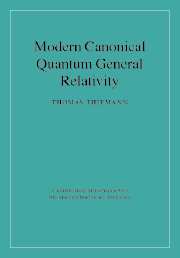Book contents
- Frontmatter
- Contents
- Foreword, by Chris Isham
- Preface
- Notation and conventions
- Introduction: Defining quantum gravity
- I CLASSICAL FOUNDATIONS, INTERPRETATION AND THE CANONICAL QUANTISATION PROGRAMME
- II FOUNDATIONS OF MODERN CANONICAL QUANTUM GENERAL RELATIVITY
- III PHYSICAL APPLICATIONS
- 12 Extension to standard matter
- 13 Kinematical geometrical operators
- 14 Spin foam models
- 15 Quantum black hole physics
- 16 Applications to particle physics and quantum cosmology
- 17 Loop Quantum Gravity phenomenology
- IV MATHEMATICAL TOOLS AND THEIR CONNECTION TO PHYSICS
- References
- Index
12 - Extension to standard matter
Published online by Cambridge University Press: 04 August 2010
- Frontmatter
- Contents
- Foreword, by Chris Isham
- Preface
- Notation and conventions
- Introduction: Defining quantum gravity
- I CLASSICAL FOUNDATIONS, INTERPRETATION AND THE CANONICAL QUANTISATION PROGRAMME
- II FOUNDATIONS OF MODERN CANONICAL QUANTUM GENERAL RELATIVITY
- III PHYSICAL APPLICATIONS
- 12 Extension to standard matter
- 13 Kinematical geometrical operators
- 14 Spin foam models
- 15 Quantum black hole physics
- 16 Applications to particle physics and quantum cosmology
- 17 Loop Quantum Gravity phenomenology
- IV MATHEMATICAL TOOLS AND THEIR CONNECTION TO PHYSICS
- References
- Index
Summary
The exposition of Chapter 10 would be incomplete if we could not extend the framework to matter also, at least to the matter of the standard model. This is straightforward for gauge field matter, however for fermionic and Higgs matter one must first develop a background-independent mathematical framework [443]. We will discuss the essential steps in the next section and then outline the quantisation of the matter parts of the total Hamiltonian constraint in the section after that, see [441] for details.
We should point out that these representations are geared towards a background-independent formulation. The matter Hamiltonian operator of the standard model in a background spacetime is not carried by these representations. They make sense only if we couple quantum gravity. Also, while we did not treat supersymmetric matter explicitly, the following exposition reveals that it is straightforward to extend the formalism to Rarita–Schwinger fields. We will follow closely [441, 443].
Before we start we comment on a frequently stated criticism: as we will see there is no obstacle in finding background-independent kinematical representations of standard matter quantum field theories and these support the matter contributions to the Hamiltonian constraint. Thus, it seems as if in LQG there is no restriction on the matter content of the world. However, that is a premature conclusion: the associated Master Constraint of geometry and matter could have zero in its spectrum depending on the type of matter coupled. Indeed, the reason why the spectrum of the Master Constraint could not contain zero is due to normal or factor ordering effects which are finite but similar in nature to the infinite vacuum energies of background-dependent quantum field theories.
- Type
- Chapter
- Information
- Modern Canonical Quantum General Relativity , pp. 399 - 430Publisher: Cambridge University PressPrint publication year: 2007

